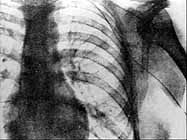The modern era of heart disease care was born from an accident, quirky personalities, and even a little daring.
The notion of heart catheterization to visualize the human heart began rather ignominiously in 1929 at the Auguste-Viktoria Hospital in Eberswalde, Germany, a technological backwater of the day. Inspired by descriptions of a French physician who inserted a tube into the jugular vein of a horse and felt transmitted heart impulses outside the body, Dr. Werner Forssmann, an eager 25-year old physician-in-training, was intent on proving that access to the human heart could be safely gained through a surface blood vessel. No one knew if passing a catheter into the human heart would be safe, or whether it would become tangled in the heart’s chambers and cause it to stop beating. On voicing his intentions, Forssmann was ordered by superiors not to proceed. But he was determined to settle the question, especially since his ambitions captured the interest of nurse Gerda Ditzen, who willingly even offered to become the first human subject of his little experiment.
Secretly gathering the necessary supplies, he made his first attempt in private. After applying a local anesthetic, he used a scalpel to make an incision in his left elbow. He then inserted a hollow tube, a catheter intended for the bladder, into the vein exposed under the skin. After passing the catheter 14 inches into his arm, however, he experienced cold feet and pulled it out.
One week later, Forssman regained his resolve and repeated the process. Nurse Ditzen begged to be the subject, but Forssmann, in order to allow himself to be the first subject, tricked her into being strapped down and proceeded to work on himself while she helplessly watched. After stanching the oozing blood from the wound, he threaded the catheter slowly and painfully into the cephalic vein, up through the bicep, past the shoulder and subclavian vein, then down towards the heart. He knew that simply nudging the rubber catheter forward would be sufficient to direct it to the heart, since all veins of the body lead there. With the catheter buried 25 inches into his body, Forssmann untied the fuming Ditzen. Both then ran to the hospital’s basement x-ray department and injected x-ray dye into the catheter, yielding an image of the right side of his heart, the first made in a living human.

Thus, the very first catheterization of the heart was performed.
An x-ray image was made to document the accomplishment. Upon hearing of the experiment, Forssmann was promptly fired by superiors for his brazen act of self-experimentation. Deflated, Forssmann abandoned his experimentation and went on to practice urology. He became a member of the Nazi party in World War II Germany and served in the German army. Though condemned as crazy by some, physicians in Europe and the U.S., after hearing of his experience, furthered the effort and continued to explore the potential of the technique. Forssmann himself was never invited to speak of his experiences outside of Germany, as he had been labeled a Nazi.
Many years after his furtive experiments, the once intrepid Dr. Forssmann was living a quiet life practicing small town medicine. He received an unexpected phone call informing him that he was one of three physicians chosen to receive the 1956 Nobel Prize for Medicine for his pioneering work performing the world’s first heart catheterization, along with Drs. André Cournand and Dickinson W. Richards, both of whom had furthered Forssmann’s early work. Forssmann remarked to a reporter that he felt like a village pastor who was made a cardinal.
Strange, but true.
Copyright 2008 House, MD